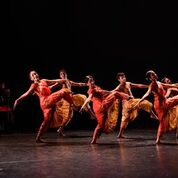
![nirantara Red - photo by Srivatsa Shandaliya copy[4] copy](https://paulacitron.ca/wordpress/wp-content/uploads/2015/05/nirantara-Red-photo-by-Srivatsa-Shandaliya-copy4-copy-300x291.jpg) South Asian choreographer Lata Pada celebrated her company’s 25th anniversary with a beautiful production called Nirantara – Beyond Space and Time. The word nirantara means endless, and what Pada hoped to bring together through dance, music, lighting and projections was the concept of the bindu (the sacred point) where time and space come together to touch the divine within.
South Asian choreographer Lata Pada celebrated her company’s 25th anniversary with a beautiful production called Nirantara – Beyond Space and Time. The word nirantara means endless, and what Pada hoped to bring together through dance, music, lighting and projections was the concept of the bindu (the sacred point) where time and space come together to touch the divine within.
Much of South Asian dance tends to embrace abstract concepts, and choreographers, like Pada, seem to accept philosophical exploration as the norm. She broke down the idea of nirantara into six sections – Beginnings – circles that never break, Outer/Inner, Longing, Architecture of time, Linger, and Full Circle. Her six gorgeous dancers, three men and three women, from both India and Canada, translated the abstractions into movement through shifting ensembles and solos that created ravishing pictures on the stage. Pada herself performed two traditional story-telling sequences which displayed her lovely hands forming the symbolic mudras or gestures.
 The section called Longing, for example, was interpreted by three male/female duets where human eroticism stood as a metaphor for divine spirituality. The finale portrayed the idea of wholeness, the bond of coming together, by starting with solos, then adding in other dancers until the six presented a united front. Pada’s choreographic vocabulary was a true Canadian hybrid that forged bharatanatyam, the classical dance of the south, to western ballet and contemporary dance, to produce a movement quality that was at once as lyrical as it was dynamic.
The section called Longing, for example, was interpreted by three male/female duets where human eroticism stood as a metaphor for divine spirituality. The finale portrayed the idea of wholeness, the bond of coming together, by starting with solos, then adding in other dancers until the six presented a united front. Pada’s choreographic vocabulary was a true Canadian hybrid that forged bharatanatyam, the classical dance of the south, to western ballet and contemporary dance, to produce a movement quality that was at once as lyrical as it was dynamic.
![Anil Srinivasan- Credit C. S. S. Lata-sm[2]](https://paulacitron.ca/wordpress/wp-content/uploads/2015/05/Anil-Srinivasan-Credit-C.-S.-S.-Lata-sm2-200x300.jpg)
![Sikkil Gurucharan-sm[2]](https://paulacitron.ca/wordpress/wp-content/uploads/2015/05/Sikkil-Gurucharan-sm2-200x300.jpg) The original live music score was unique because it included a piano, definitely a western instrument, coupled with Carnatic singing. The latter is the classical music of South India. The insertion of rippling piano music coupled with traditional vocals and instrumentation made for a unique expression. Apparently Pada had been inspired by a concert in Chennai (Madras) featuring vocalist Sikkil Gurucharan and pianist Anil Srinivasan, and invited them to compose and perform the score for the 25th anniversary show (with the addition of percussion and the stringed sarangi).
The original live music score was unique because it included a piano, definitely a western instrument, coupled with Carnatic singing. The latter is the classical music of South India. The insertion of rippling piano music coupled with traditional vocals and instrumentation made for a unique expression. Apparently Pada had been inspired by a concert in Chennai (Madras) featuring vocalist Sikkil Gurucharan and pianist Anil Srinivasan, and invited them to compose and perform the score for the 25th anniversary show (with the addition of percussion and the stringed sarangi).
Arun Srinivasan’s lighting was itself a thing of beauty that captured both the delicacy and the vibrancy of the dance, as were the lovely costumes by Pada herself. The latter included several changes of traditional bharatanatyam dress along with uni-gender western pants and tops. Jacques Collin’s projections of symbols and mandalas suitably complemented the abstract theme.
 Like many South Asian dance concerts, the show was a trifle long. As well, the music was a tad the same over time. Each section was introduced by a long musical interlude by both pianist and singer, but there was little variation in either. Above, I described the piano music as rippling, to which I can add gentle, neo-romantic musings in the Keith Jarrett vein. Western audiences do not understand Carnatic lyrics, so in essence, a good chunk of any production is rendered out of touch. I have often said that South Asian choreographers should include translations so we non Hindi/Urdu speakers can grasp what is being sung.
Like many South Asian dance concerts, the show was a trifle long. As well, the music was a tad the same over time. Each section was introduced by a long musical interlude by both pianist and singer, but there was little variation in either. Above, I described the piano music as rippling, to which I can add gentle, neo-romantic musings in the Keith Jarrett vein. Western audiences do not understand Carnatic lyrics, so in essence, a good chunk of any production is rendered out of touch. I have often said that South Asian choreographers should include translations so we non Hindi/Urdu speakers can grasp what is being sung.
Nonetheless, Nirantara was a compelling performance that was a feast for both the eyes and the ears. Pata’s 25th anniversary production was a stunning example of a master craftsperson at the height of her powers.
(Sampradaya Dance Creations/Nirantara – Beyond Space and Time, Fleck Dance Theatre, May 24 to 26, 2015.)
